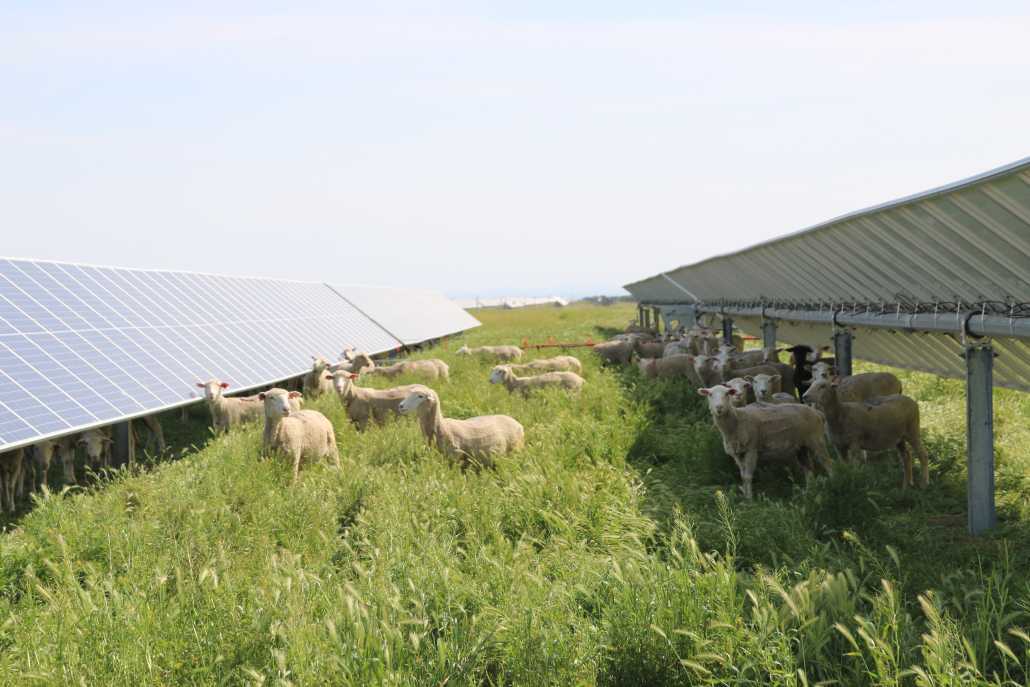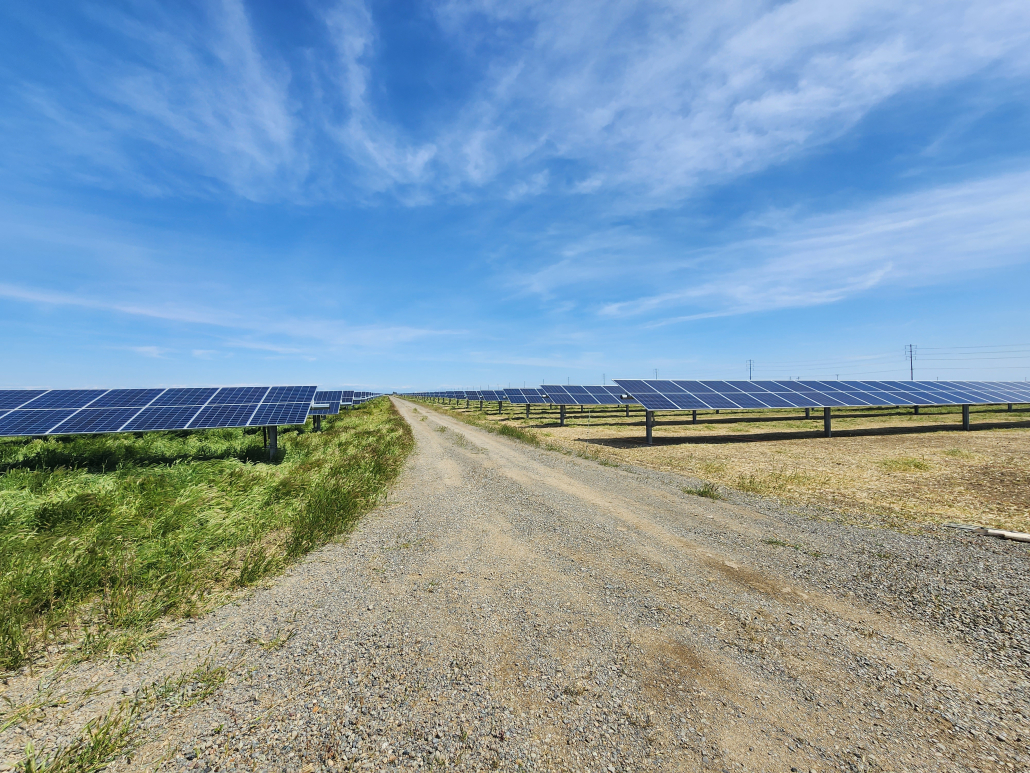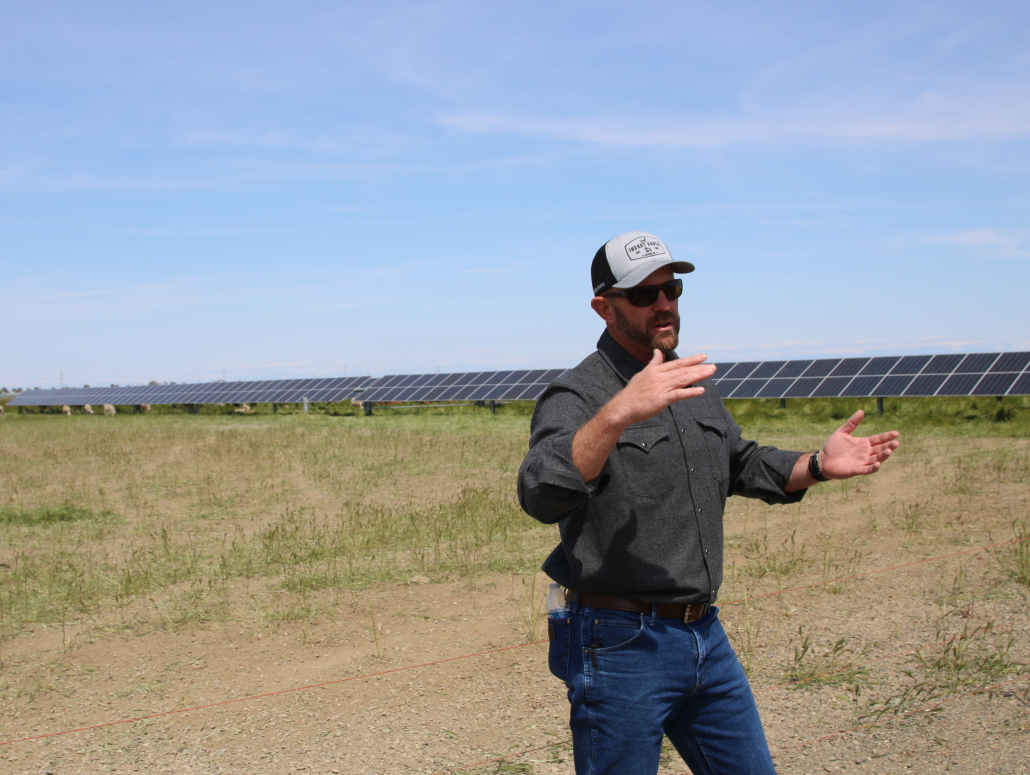In this video, Max Greene and Emily Griffith of Renewable Northwest discuss the state of agrisolar development in the Pacific Northwest.
In this video, Max Greene and Emily Griffith of Renewable Northwest discuss the state of agrisolar development in the Pacific Northwest.

Indart sheep between rows of solar panels.
By Anna Adair, NCAT Energy Program Assistant
As the average age of the American farmer continues to rise, the question of how to transition an agricultural operation to the next generation is a concern for current farmers. Can agrisolar offer a solution to help keep multi-generational farms and ranching operations profitable and in family hands? For Ryan Indart and his family in Clovis, California, solar grazing has given them the opportunity to not only keep their sheep operation up and running, but also to expand the business to include multiple partners and grazing sites across state lines.
The Indarts have been ranching and farming in California for generations. Ryan’s grandfather first introduced the family to ranching when he purchased 1,000 sheep in 1937, later selling the wool to the U.S. government to clothe American soldiers in World War II. His parents bought the operation in 1970 and ran the business for nearly 40 years before it was his turn to carry on the family legacy. However, his parents didn’t simply hand over the operation, and Ryan worked tirelessly to reach his goal of taking over the business.
Although he had moved away from his family land after college, Ryan always loved the sheep and wanted to return to raising them eventually. He knew he needed to earn enough money to either purchase his family’s operation or start one of his own. After earning his MBA from Notre Dame in 2002, he worked in commercial real estate for several years before he and his wife Beatriz moved back to Frenso County and purchased all aspects of the family business, from equipment to the sheep themselves.
The early years were far from stress-free, however. Like many farming families in America today, the Indarts struggled to turn a profit year after year. In addition to raising sheep for wool and lamb, they did tractor work and dry farmed a variety of crops, but none of their hard work reliably produced a consistent profit. Rising wages and the increased cost of living in California led them to seriously consider moving out of the area Ryan’s family has called home for generations. Thankfully, a single phone call set the family on a new course and opened the door for the creation of Indart Solar Sheep Grazing.
In 2018, Ryan received a call from a solar developer with a 1,600-acre solar facility in western Fresno County. Large solar systems were just beginning to pepper the Central California landscape, and the developer was looking for a local sheep grazier to help manage vegetation at the site. They reached out to the California Wool Growers Association, where Ryan was serving as President, and were directed to the Indarts’ operation. When the developer offered to compensate the family for their grazing services, Ryan thought “This could be a gamechanger.” He signed his first solar grazing contract just a few short months later and spent the rest of 2018 and 2019 expanding Indart Solar Sheep Grazing.

Comparison of land grazed (right) versus not grazed by Indart sheep at the Slate Solar Facility in Kings County, California.
Today, Indart Solar Sheep Grazing includes multiple grazing partners that share the Indarts’ high degree of professionalism, and Ryan takes a lot of pride in setting a value standard for the solar grazing industry. “We run an organized business. Whenever there’s a problem we’re always there to help solve it,” he says. Including partnerships, Indart Solar Sheep Grazing has over 10,000 sheep grazing over 15,000 acres from northern California to Arizona.
Ryan is a wealth of knowledge but has one particular piece of advice for established farmers considering venturing into solar grazing: get comfortable with being uncomfortable. After his first contract in 2018, he regularly cold called solar companies whose facilities he saw in the area, offering them his services as an experienced grazier. “You’ve got to be willing to challenge your fears. Try something new. Make a phone call,” he says. “The worst thing that can happen is they say no.” He emphasizes that farmers must be willing to try new things and adapt to the current state of agriculture in the United States. “That’s what’s made us successful.”

Ryan Indart discussing solar grazing during the Central California Follow the Sun Tour with the AgriSolar Clearinghouse.
For new farmers trying to break into the agricultural industry, Ryan believes the barriers of entry to solar grazing are fewer than those encountered in traditional farming scenarios. Land access is a common hurdle for first generation farmers, but solar grazing provides immediate access to acres of land, often with quality forage for grazing animals. Contracts with site owners also mean farmers are making money throughout the year, rather than just during lambing season. “You have instant access to revenue,” Ryan says.
Looking to the future, the Indarts plan to continue expanding their business. With just over 3,500 sheep in their personal flock, the family’s goal is to reach about 5,000 animals total. Ryan says they may be more strategic about what clients they take on as well, and subcontract with other sheep graziers who share their business values as they reach the limit of where they can graze themselves. “It’s a huge blessing to be able to stay in business in California,” Ryan says. “But I couldn’t do this without a support system.”
When speaking about his company’s success, Ryan credits his family and team members that have been with him for years. Many of the team members are originally from Peru, and employment with the Indarts’ business has provided them with the opportunity to send their children to school or buy a home for their family. “I’m very grateful I can provide jobs for these guys, and help them better their lives,” Ryan says. “That’s what makes me happy.”
Finally, Ryan states that it’s wonderful to be a part of the renewable energy movement but emphasizes that “We’ve been doing this for generations.” With proper grazing techniques, graziers have helped improve plant diversity and soil health for years before solar grazing entered the scene. Ryan says he’s proud to continue what his grandfather started, and thankful for the chance to create jobs and opportunities for his employees that have become a part of his family.
All photos by NCAT.
500MW of Community Solar to be Deployed by Community Solar Collective
“Aggreko Energy Transition Solutions (ETS), a business unit of Scottish modular power equipment distributor Aggreko Ltd., announced it would become the capital partner to the Farmers Powering Communities (FPC) platform, a farmland community solar development collective. With preservation and non-profit groups Edelen Renewables, the American Farmland Trust and community solar aggregator Arcadia, the FPC platform is focused on building out 500 MW of community solar projects over the next decade sited on rural farmland.
The farming community solar program will advance projects of 25 to 50 acres to provide green energy to the many residents who don’t have access to rooftop solar or a local clean energy source. These could be low- to middle-income residents who may not be able to afford solar, people who rent and don’t own their roof, or people whose homes are not situated to take advantage of the sun’s energy.” – PV Magazine
Jack’s Solar Garden Hosts Agrivoltaic Bill Signing
Colorado governor Jared Polis recently signed Colorado Senate Bill 092. The bill signing was attended by Senator Chris Hansen; Representative Karen McCormick, DVM; and Colorado Commissioner of Agriculture Kate Greenberg. The signing was hosted at Jack’s Solar Garden, an agrisolar operation in Boulder County, Colorado, and one of the largest agrivoltaic operations in the country.
“In support of the use of agrivoltaics, which is the integration of solar energy generation facilities with agricultural activities, section 2 of the bill authorizes the agricultural drought and climate resilience office to award grants for new or ongoing demonstration or research projects that demonstrate or study the use of agrivoltaics.” – colorado.gov
Oregon State University Shows Benefits of Agrivoltaics
“On a small research farm outside of Wilsonville, Chad Higgins feels like he’s watching the future of farming and energy production unfold. Higgins, a biological and environmental engineering professor at Oregon State University, oversees one of the largest experiments in agrivoltaics in the world.
Using agrivoltaic systems, Higgins has grown tomatoes with bigger yields and dry beans with higher protein content. He’s raised sheep in pastures under solar panels and, though the sheep don’t grow any faster, he’s able to graze more of them per acre because the grass grows more quickly. He’s also found that, because the plants cool the environment around them, the solar panels don’t run as hot and produce energy more efficiently.” - KGW
The aim of this research is to establish how relevant agrivoltaics can be in terms of energy production at regional scale. For this purpose, a methodology is developed to: (i) identify greenhouses using cartographic information systems, (ii) estimate how much of these areas could be covered by solar photovoltaic panels without decreasing the crops production, thus, estimating the optimal photovoltaic cover ratio for different type of crops under different solar conditions by developing a novel set of equations and (iii) evaluate the corresponding photovoltaic power and production.
In this paper, researchers quantify floating photovoltaic impacts on lake water temperature, energy budget and thermal stratification of a lake through measurements of near-surface lateral wind flow, irradiance, air and water temperatures at one of the largest commercial German facilities, situated on a 70 m deep dredging lake in the Upper Rhine Valley, South-West Germany.
This paper looks at the use of photovoltaic thermal air collectors (PV-T) and integrated greenhouse drying systems. It offers insights and data to aid scientists and researchers in the creation and improvement of thermal models for combined solar systems, and presents a detailed analysis of the current state of knowledge in the field of combined solar systems. It also identifies gaps in the existing research and suggests potential avenues for future investigation.
In this article, the authors conducted a qualitative study revolving around three methodological approaches: a press analysis, a review of scientific literature, and fieldwork in the Pyrénées-Atlantiques district in France. Their analysis highlights four main results: (i) agrivoltaism is an innovation conceptualized in techno-scientific arenas which seek to define its agricultural viability; (ii) at the national level, the remote control by the State does not provide a framework for governance capable of involving the various actors in the fields of agriculture and energy; (iii) the deployment of agrivoltaism systems across regions engenders conflict while placing key local actors in a situation of uncertainty with regard to how best to manage this innovation; (iv) while individuals are subjected to territorialization, this paradoxically favors structural policy innovations which outline the contours of territorial governance.
This guide serves to help landowners navigate the complex and challenging decision process of whether to enter a solar lease. It presents key issues to consider and information to gather prior to making a decision, offers communication skills to help guide conversations with others connected to the land, and provides tips and tools for negotiating with the solar company on the terms of a solar lease.
Written for the AgriSolar Clearinghouse by Alexis Pascaris (Agrisolar Consulting) and Allison Jackson (Colorado Agrivoltaic Learning Center)
The Agrisolar Policy Guide was designed to facilitate policy learning and innovation in the United States. By collating existing initiatives and key provisions, this guide serves as a resource for regulators, land use planners, decision makers, and others who are interested in state-of-the-art agrisolar policy. The AgriSolar Clearinghouse is impartial towards policy; the intention of this guide is not to advocate for certain initiatives, but to provide a central platform for education and engagement. The goal of this guide is to support policy innovation for better co-location.
This episode is a conversation between NCAT Energy Program Director Stacie Peterson and Alexis Pascaris, executive director of AgriSolar Consulting.
It is the fifth in a series of AgriSolar Clearinghouse podcasts that are being featured on ATTRA’S Voices from the Field podcast.
Alexis is a consultant and a stakeholder in the AgriSolar Clearinghouse. She and Stacie discuss the social aspects of agrisolar, including the concept of energy as a social matter with technological components, the importance of the cultural landscapes around agrisolar operations, and the “social license” to operate them. Alexis and Stacie also address the stacked benefits of agrisolar itself and agrisolar projects around the country.
Related NCAT Resources:
Other Resources:
Contact Stacie Peterson at stacieb@ncat.org.
Please complete a brief survey to let us know your thoughts about the content of this podcast.
You can get in touch with NCAT/ATTRA specialists and find access to our trusted, practical sustainable-agriculture publications, webinars, videos, and other resources at ATTRA.NCAT.ORG.
This material is based upon work supported by the U.S. Department of Energy’s Office of Energy Efficiency and Renewable Energy (EERE) under the Solar Energy Technologies Office Award Number DE-EE000937. Legal Disclaimer: The views expressed herein do not necessarily represent the views of the U.S. Department of Energy or the United States Government.